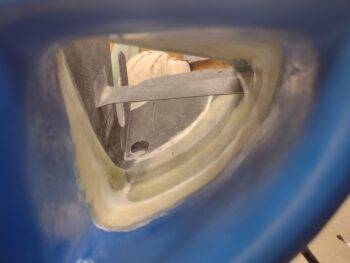I had a lot of external stuff going on today, so it was a light build day along with a fair bit of research.
I pulled the peel ply, razor trimmed and cleaned up the layups on the left aft inlet ramp…
. . . and the right front inlet ramp.
And then grabbed a shot of each through the armpit intake.
I then cleaned up the areas on the inboard undersides and sidewalls for the final single-ply BID tape layup to secure the aft left and front right ramps in place.
After cutting the glass, I then laid up and peel plied the last layup on the aft left ramp.
As well as the front right ramp.
I got an email late last night from my contact on the inner baffle molds, so if all goes right I should be getting them within the following week.
The news on the inner baffle molds along with a discussion with Dave Berenholtz on baffling, including the article “Design for optimum cooling efficiency” by Andreas Christou, triggered some thoughts I had on cooling in regards to the Mike Melvill cowling. I thought I would include some of what I wrote to Dave here. Feel free to respond if you have thoughts or insights on this:
“A couple of interesting things in the article is that he mentions a 140° gap on the intake side and I honestly think few canardians actually do that, although I heard it mentioned on Gary Hertzler’s Oshkosh round robin video as everybody nodded their conformational agreement. In the same vein, does anybody go without bottom inter-cylinder baffles as he shows in his diagrams (albeit for tractor)?
Reading that document and then Klaus’ email to you gave me a bit of an A-ha! moment with these Melvill cowlings. As I’ve been working on installing the inner air intake walls and the inlet ramps, I note that the armpit intake configuration is definitely geared at getting the air to the outer cylinder fins. I guess one could make an argument that these are the most important overall for cooling, and I’m guessing (along with Mike Melvill’s statements & data) that these armpit inlets definitely do just that. They do seem to keep the CHTs low and in check.
But back to the doc for a moment: Christou states in there that; “Oil temperatures can be brought under control with good cylinder base baffles.” I think this statement shows the weakness of the armpit intake setup and the strength of the bottom NACA cooling duct as Klaus points out. It may also be a big reason why Melvill was having oil cooling issues and needed a bigger oil cooler because all the cooling air is flooding the outer cylinder fins with great cooling air, but the base cylinder fins are comparatively getting starved without direct air feed (although I thought it was supposed to be all about pressure vs direct air velocity… hmmm?).
I think in general terms a NACA cooling system is probably the best overall way to go, if you can dial it in to work. I know Marco’s bird JT has a Klaus NACA duct on it and I’m sure Klaus’ is obviously as spot on NACA-wise as you can get. A good NACA should get very acceptable cooling air to all cylinders, both at the cylinder heads and bases, and that would account for JT’s smaller oil cooler… with no issues on any of it.”
With all that being said, tomorrow I plan on getting the last ramp installed as well as beginning on the aluminum ramp vanes.






